Flagship Programs
Following the new conceptual framework outlined here, these Research Highlights are identified as contributing to understanding Earth Architecture (the roadmap for fluids) and/or Fluid Fluxes (the “traffic report”), with logos for easy attribution.


1. DEEP-EARTH FLUIDS IN COLLISION ZONES AND CRATONIC ROOTS (TARDIS II)
Themes 1, 2 and 3, Early Earth, Earth's Evolution and Earth Today, contributing to understanding Earth's Architecture and Fluid Fluxes.
AIMS
This program investigates the role of fluids in the deep mantle and lithosphere, using studies of kimberlites and other volcanic rocks, xenoliths of mantle and crustal rocks in volcanic rocks, ophiolites, and UHP terrains related to subduction zones. Super-reducing, ultra-high-pressure (SuR-UHP: 400-600 km) mineral assemblages in some ophiolites carry implications for the evolution of fluid compositions, reactions and redox states in subduction environments from the surface to the Transition Zone, and suggest a new geodynamic collision process that may improve mineral exploration concepts for paleosubduction regimes. The recent discovery of similar ultra-reduced mineral assemblages in ejecta from Cretaceous volcanoes in Israel suggests a previously unrecognised process of interaction between highly reducing deep-mantle fluids and ascending basaltic magmas. We aim to produce an experimentally testable model for the generation of such fluid conditions in the mantle, to quantify constraints on the geochemical and tectonic processes that have produced SuR-UHP assemblages, and to produce a geodynamic model for these processes.
2019 REPORT
The TARDIS project continued in 2019 to carry out research on significant questions relating to kimberlite genesis, the petrogenesis of super-reduced magmatic systems, the evolution of the North China Craton, magmatism and tectonics in the Tethyan collisional belt, and the mantle beneath the Pannonian Basin in Hungary.
Kimberlites: Andre Giuliani and coworkers (CCFS publication #1329) used core-to-rim analyses of oxygen isotopes in olivine macrocrysts in kimberlites to show that most of these olivine grains were derived from peridotites in the subcontinental lithospheric mantle, while their rims crystallised from the kimberlitic melts, which had assimilated variable proportions of mantle material. Building on this basis, they concluded that kimberlites worldwide represent very similar primary magmas, modified to varying degrees by assimilation of SCLM material (CCFS publication #1488). This new model greatly simplifies research into the origins of kimberlitic magmas. Nkere et al. (CCFS publication #1354) and Batumike et al. (CCFS publication #1344) carried out in situ U-Pb dating of groundmass perovskite in kimberlites from the Democratic Republic of the Congo, adding more data on the distribution of some of Earth’s youngest kimberlites. One of the standards used in this work, the Mud Tank zircon, was documented by Gain et al. (CCFS publication #1330), enhancing the use of this widely distributed material in laboratories worldwide. Montgarri Castillo-Oliver et al. (CCFS publication #1421) followed up last year’s major study on the petrography of primary and secondary carbonates (CCFS publication #1184) with a detailed petrographic-isotopic study of the famous carbonate parageneses from the Benfontein kimberlite sills in South Africa. Their multi-technique approach not only revealed the petrographic and geochemical complexity of carbonates in kimberlites in unprecedented detail, but also allows identification of the processes that led to their formation. The narrow range of isotopic variation in primary carbonates suggests that kimberlites are derived from a mantle source with little contribution from recycled crustal material, and complements the results of Giuliani et al. (CCFS publication #1488).
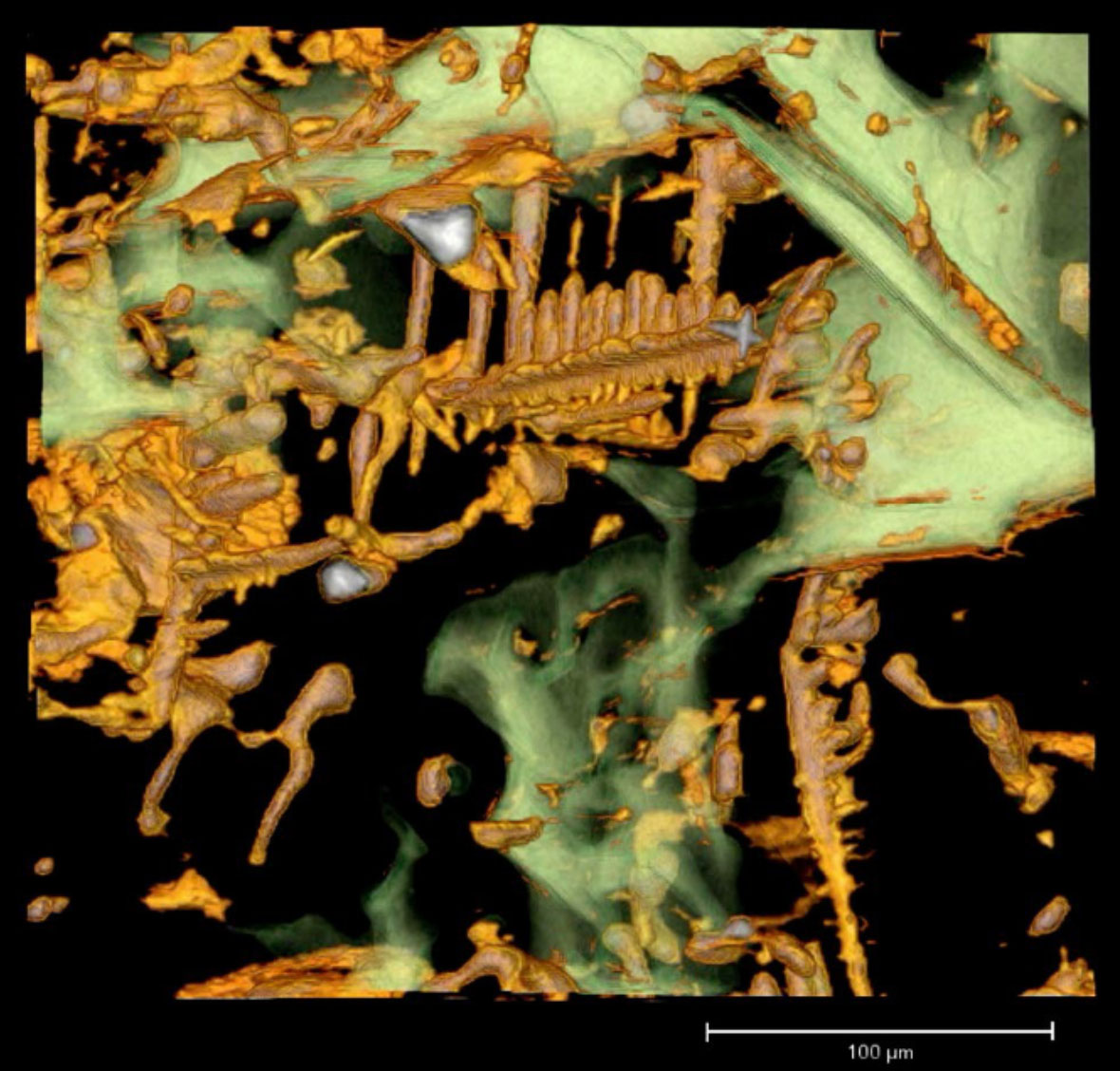
3D-micro CT image of a small piece of Carmel Sapphire, part of the ultra- reduced magmatic assemblages, Mt Carmel, Israel. This image shows the distribution of corundum (black), silicate melt (green), fluid-filled voids (red) and metallic melts, including Ti oxynitrides (orange). View the 3D rotating image here
Ultra-reduced magmatic assemblages, Mt Carmel, Israel: Significant progress was made in this subproject this year, most of which will be published or submitted in 2020. 2019 saw the publication of a trio of papers centred on the hibonite- grossite-vanadium assemblage found as complex, coarsely- crystalline grains in the alluvial deposits derived from the Cretaceous pyroclastic volcanoes on Mt Carmel. The main paper (CCFS publication #1209) is the first report of a terrestrial magmatic hibonite-grossite assemblage, though these minerals are common in the Calcium-Aluminum Inclusions (CAIs) in carbonaceous chondrite meteorites. The presence of native vanadium in this assemblage testifies to extremely low oxygen fugacity (fO2), ca 9 log units below the Iron-Wustite buffer that probably controls the fO2 of Earth’s mantle. This very low fO2 is similar to that of the early Solar nebula, and implies the presence of a fluid phase dominated by H2. This was spectacularly confirmed when sharp-eyed collaborator Luca Bindi (University of Florence) identified a tiny grain of 3D-micro CT image of a small piece of Carmel Sapphire, part of the ultra- reduced magmatic assemblages, Mt Carmel, Israel. This image shows the distribution of corundum (black), silicate melt (green), fluid-filled voids (red) and metallic melts, including Ti oxynitrides (orange). View the 3D rotating image a here vanadium dihydride (VH2) associated with the native vanadium in one sample (CCFS publication #1360). This is the first naturally occurring metal hydride, and has been submitted for approval as a new mineral - kishonite (for the Kishon River from which the sample came). This unique observation was further supported by collaborator Fernando Camara (University of Milan), who used Raman spectroscopy to infer the presence of H2 in the hibonite adjacent to inclusions of vanadium. These discoveries shed important new light on the transfer of volatiles from the reduced sublithospheric mantle, and represent several more bricks in the construction of a complete model for the Mt Carmel magmatic system.
North China Craton (NCC): Work in 2019 focused on the evolution and nature of the lower crust beneath the craton and adjacent areas. Dai et al. (CCFS publication #1360) used basalts and xenoliths from the Langshan area to infer the presence of subducted oceanic material beneath the northern edge of the North China Craton (NCC), while Ping et al. (CCFS publication #1396) showed that the lower crust is younger than the mid- to upper-crust beneath the southeastern part of the NCC. Ma et al. (CCFS publication #1225) used seismic data and xenolith references to show that the lower crust is similar in composition and thickness beneath the ‘disrupted’ NCC and the adjacent ‘intact’ Ordos block. This is a powerful argument against the widely promoted idea that the Mesozoic-Cenozoic disruption of the SCLM beneath the NCC was driven by delamination of the lower crust.
Pannonian Basin: The Nógrád-Gömör Volcanic Field (NGVF), in the northern Pannonian Basin in Central Europe, is one of five key localities where the lithospheric mantle of the Carpathian- Pannonian region can be studied using peridotite xenoliths hosted in late Miocene to Pleistocene alkali basalts. Liptai et al. (CCFS publication #1361) published a major study documenting the regional distribution of microstructural characteristics in the xenoliths. The lateral variations in microstructures record deformation by dislocation creep in a transpressional regime, which is consistent with recent tectonic evolution in the Carpathian-Pannonian region, associated with the convergence of the Adria microplate and the European platform. The microstructures also contribute to a better understanding of the regional seismic data. Despite well-developed fabrics in the xenoliths, which imply a strong seismic anisotropy, the lithospheric mantle alone most likely cannot account for the shear wave splitting delay times measured in the NGVF, indicating that deformation in both the lithosphere and the asthenosphere contributes to the observed shear wave splitting. In a related study, Patko et al. (CCFS publication #1239) used FTIR spectroscopy to measure hydroxyl contents in the major minerals of NGVF xenoliths, and found them to have unusually low H contents. These probably are not representative of the upper mantle beneath the region, but reflect the loss of H during high-temperature annealing (before and during eruption) and relatively slow cooling in the erupted basalts.
Tethyan Belt: Work in 2019 focused on the petrological and tectonic evolution of the continental crust of northern Gondwana, now found in accretionary terranes in both Iran and Tibet. Moghadam et al. (CCFS publication #1381) documented the generation of the Cadomian (570-525 Ma) crust of NE Iran in a continental-margin arc under very high magmatic fluxes in a ‘crustal hot zone’ that involved interaction between mantle- derived melts and old continental crust. Synthesis of new and published data indicates that this type of interaction is common during periods of high magmatic fluxes. The results indicate that differentiation of mafic melts in the lower crust during prolonged magmatic flare-ups plays a key role in building a stratified continental crust. Using data from Late Cretaceous ophiolites in NE Iran, Moghadam et al. (CCFS publication #1236) unravelled the processes of the subduction initiation and back- arc opening north of Neo-Tethys, which eventually separated the Cadomian crust from Gondwana and sent it off to join Europe- Asia. Kazemi et al. (CCFS publication #1199) studied related late Cretaceous subduction along the Lut Block in NE Iran, a largely covered stable crustal block with a history back to the Archean, also once part of Gondwana. In another part of Tethys, Zhou et al. (CCFS publication #1213) used zircons from Neoproterozoic sedimentary rocks exposed in the basement of the Lhasa Block in Tibet, the last terrane to arrive before the collision of India with Asia, to connect this terrane with the Himalaya and/or the East Africa Orogen. These results show that the Lhasa Block was probably located within a giant convergent plate margin system surrounding the Rodinia supercontinent during its breakup in Tonian time (850-1000 Ma). Continuing geochemical studies related to porphyry copper deposits are revealing the processes and conditions that lead to significant economic deposits (e.g. CCFS publication #1230).
WORKPLAN 2020
Kimberlites and related rocks: Work will continue on the isotopic characteristics of kimberlites and related rocks, focusing on two major questions: what does a “primitive” kimberlite look like, and how is it generated?Ultra-reduced magmatic assemblages, Mt Carmel, Israel: The focus of this subproject will be to achieve a complete synthesis of the unusual mineral assemblages from this remarkable locality and the conditions of their formation. This will require studies of mineral assemblages formed at (relatively) oxidising conditions. Further analytical work will be required, but limited in scope. Plans to begin in situ studies of the isotopic systematics of Ti, N and O isotopes in the ultra-reduced minerals have been disrupted by the global pandemic, but we hope to make progress during 2020. Further analyses of the isotopic composition of included gasses will be carried out in Beijing, and another Beijing lab will analyse Si and C isotopes in more SiC samples.
North China Craton: A large-scale seismic survey and further studies of xenolith suites will examine the uppermost mantle and lower crust, and the Mantle Transition Zone beneath the NCC, to investigate the effects of repeated subduction beneath the region, and the transfer of fluids and magmas from the MTZ to the crust.
Tethyan Belt: Work will continue on the magmatic and structural evolution of the Tethyan Belt in Iran, leading to a synthesis of the development of the northern edge of Gondwana, the detachment of a series of microcontinents, and their amalgamation to the European continent. Work in Tibet will focus on the role of the lithospheric mantle as a reservoir for volatiles and ore-forming elements concentrated in Cu-Mo-Au porphyries, and the origin of ore deposits in ophiolitic massifs.
Published outputs for 2019
CCFS publications: #1199, 1209, 1213, 1225, 1230, 1236, 1239, 1249, 1245, 1256, 1329, 1330, 1344, 1354, 1360, 1361, 1365, 1367, 1377, 1396, 1399.
<20 Conference Abstracts

2. GENESIS, TRANSFER AND FOCUS OF FLUIDS AND METALS
Themes 2 and 3, Earth’s Evolution and Earth Today, contributing to understanding Earth’s Fluid Fluxes.
AIMS
This program embodies a holistic approach to ore deposit research, acknowledging that the genesis of mineral occurrences requires the conjunction in time and space of three main independent parameters: fertility, lithosphere-scale architecture, and favourable transient geodynamics. In this context, the integrated studies in this Flagship program address the critical link between metal source fertility and four-dimensional evolution of multi-scale fluid pathways that ensure efficient mass and fluid flux transfer between the mantle and the upper crust. Our studies test the hypothesis that the genesis of sizeable mineral deposits is the end product of self-organised critical systems operating from the scale of the planet all the way to the very focused environments where ore deposits can form. This Flagship Program is not commodity-focused but rather looks at the basic commonalities among various mineral systems to unravel the main constraints in the formation of ore systems.2019 REPORT
In 2019, this Flagship Project acted as a gravity well, attracting numerous researchers and students from a variety of universities to work with analytical infrastructure based at UWA. Work mainly focused on establishing the cycle of volatiles and metals at the scale of the lithosphere. Past and ongoing projects have significantly contributed to and engaged industry and generated new projects on various mineral systems. These include partnerships with:
- • Anglo American and CSIRO to investigate the potential of silicate and oxide phases to be used as resistate indicator minerals in the exploration for magmatic nickel sulfide ores
- • Panoramic Resources and Innovation Connections, in partnership with the Commonwealth government, investigating the role of high-precision geochronology as a tool to unveil the timescales of ore forming processes in magmatic systems
- • IGO to characterise the geochemical and isotopic signature of mafic and ultramafic rocks in the Proterozoic Albany-Fraser Belt, Yilgarn Craton, Western Australia
- • Auldana to characterise volcanic and sedimentary records and unravel the convergence and amalgamation of the continental arcs and terranes of north-eastern Thailand
In 2019, overseas field work activities for this Flagship Project focused on the Ivrea Zone (see photo below) of northwest Italy, northern Thailand, and along the southern Andes in Chile. In the Ivrea Zone, work focused on the La Balma Monte Capio intrusion, investigating how metals and volatiles are recycled along the margins of continental blocks during subsequent magmatic episodes spanning tens of millions of years. In northern Thailand, the work principally aimed at sampling magmatic suites in order to build an isotopic map of that lithospheric domain. In Chile, the work aimed at establishing the nature of fertility signals in whole-rock and mineral (zircon, apatite) datasets in relation to ore porphyry systems, with special emphasis on the chronology of events. In Australia, field work focused on the Agnew-Wiluna (AWB) and Fraser belts of the Yilgarn Craton on Western Australia, in the context of the ongoing Yilgarn 2020 project (AWB) and collaboration with IGO (Fraser belt).

Marco Fiorentini (pictured) hiking through the Italian Alps with Postgraduate students Gregory Dering and Joshua Chong to investigate the metallogenic architecture of the magmatic Ni-Cu-PGE sulfide deposits associated with the Jurassic magmas of the Ivrea Zone (see CCFS postgraduates section).
WORKPLAN 2020
Work in 2020 will be carried out within the framework of a number of ongoing PhD projects, mainly funded by ARC or industry, and the work of ECRs at UWA. Ms Eunjoo Choi will submit her PhD thesis in early 2020. Her work focuses on unravelling the significance of Proterozoic magmatism in the Yilgarn Craton as a probe to unravel the first-order control on its metallogenic fertility and endowment.
Published outputs for 2019
CCFS publications: #1198, 1210, 1214, 1289, 1342, 1343, 1356, 1358, 1359, 1380.
16 Conference Abstracts

3. MODELLING FLUID AND MELT FLOW IN MANTLE AND CRUST
Themes 2 and 3, Earth’s Evolution and Earth Today, contributing to understanding Earth’s Architecture and Fluid Fluxes.
AIMS
Many aspects of Earth Science, from ore deposits to giant earthquakes, depend critically on the complex interaction of solids and fluids. Numerical simulation of these processes and effective visualisations of the results is critical to understanding how these Earth system components work, but our ability to do this is currently very limited. Flagship Program 3 is developing the next generation of numerical codes and aims to refine the thermodynamic parameters involved by integrating high- pressure experiments to handle these complex problems. This will lead to important improvements in the quantification and visualisation of Earth processes, and will be applied to a variety of geodynamic situations.
The new high-pressure experimental group at Macquarie joins this initiative to provide input on physico-chemical parameters of minerals, melts and fluids in the deep mantle, the composition of melts that infiltrate the lithosphere, and their effects on its geodynamics and stability.
2019 REPORT
The two major outcomes from this program have been the development and expansion of Litmod and its subsidiary codes, led by CI Afonso, and the technical implementations of CCFS modules into the community code Aspect, leading to new community-available modules for handling complex physical processes.
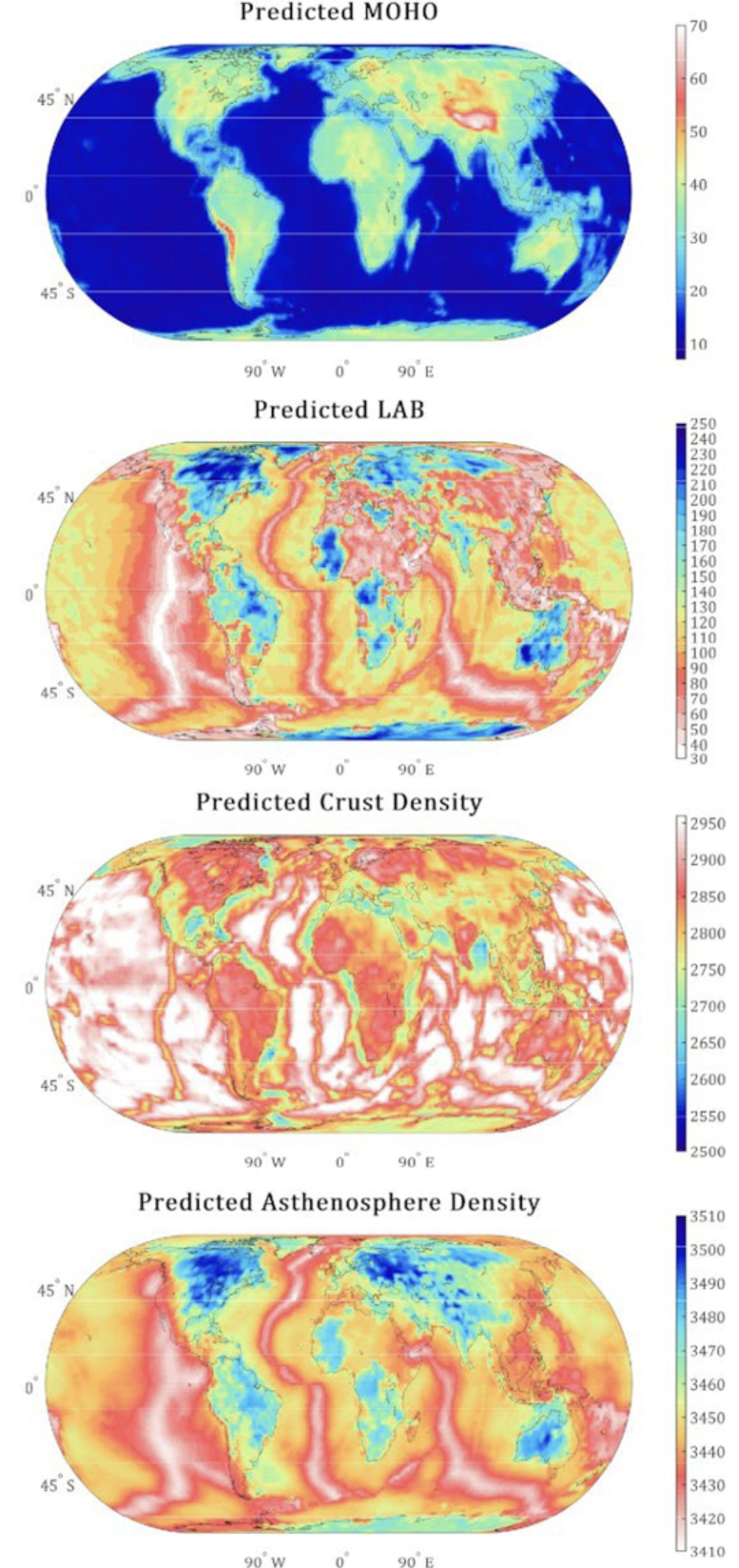
Figure 1. LithoRef18, a new global model for the Earth’s lithosphere and upper mantle obtained through a formal joint inversion of 3D gravity anomalies, geoid height, satellite- derived gravity gradients and absolute elevation complemented with seismic, thermal and petrological prior information. The model includes crustal thickness, average crustal density, lithospheric thickness, depth- dependent density of the lithospheric mantle, lithospheric geotherms, and average density of the sublithospheric mantle down to 410 km depth with a surface discretisation of 2°×2°. See CCFS publication #1234.
The science outcomes from these developments in the past year include i) A recognition of meteorite impacts as a geological process in the Archaean record, and a demonstration of the ability of Archaean spherule-bed forming impacts to generate tectonic responses in the Archaean geological record. This has been published in the high-profile journal Geology in 2020. ii) The development of LithoRef18: A global reference model of the lithosphere and upper mantle from joint inversion and analysis of multiple data sets, presented in Afonso et al. (CCFS publication #1234, Fig. 1) in the journal Geophysics Journal International, and available for download here. iii) Improved seismic models of the structure of the Chinese lithosphere and the influence of subduction in this area. Results were published in Zhang et al. (CCFS publication #1481), and Xu et al. (2020, Geology, CCFS publication #1483).
The newly renovated and expanded high-pressure experimental laboratory was opened in 2019, with two multi-anvil apparatuses (Fig. 2) to add to the existing 500-ton multi-anvil from the old laboratory. In January 2020, two new piston- cylinder apparatuses were delivered and installed by GUKO Sondermaschinenbau (Germany; Fig. 3).
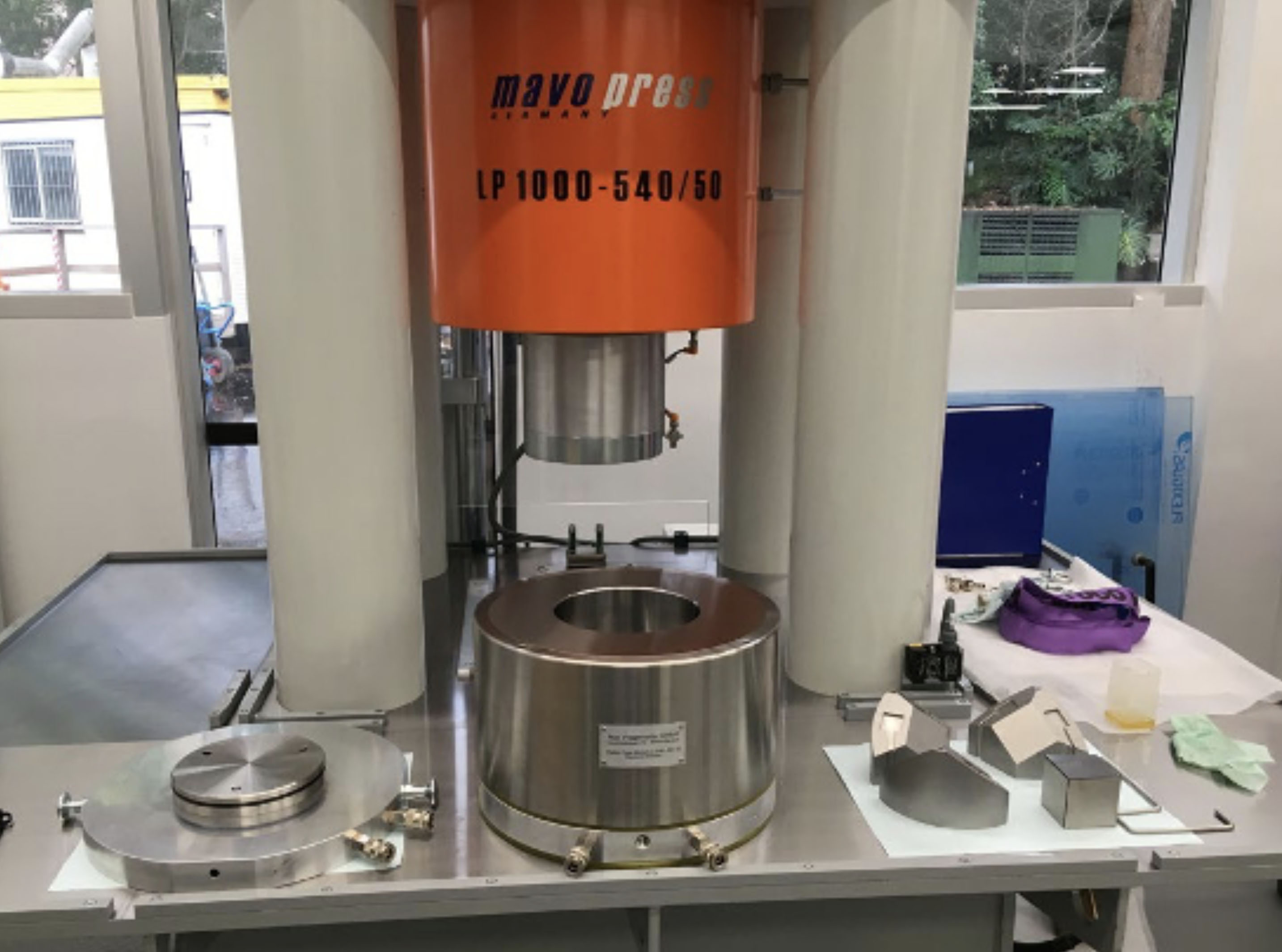
Figure 2. 1000-ton multi-anvil apparatus from Voggenreiter GmbH.
Whilst the laboratory was closed, experiments in this Flagship Program were continued at the ANU, Frankfurt, Mainz and Wuhan, with projects including reaction experiments with sedimentary rocks and mantle peridotites (Michael Förster, Mingdi Gao and Chunfei Chen) and partial melting of mantle peridotites with different mixtures of volatile components (Zsanett Pintér and Zairong Liu). The scope of sedimentary materials included in the experiments has widened considerably and is chosen to represent major contributors to material in subduction zones. Michael Förster has been looking at reactions with marine sediments from the Mediterranean, whereas Chunfei Chen is investigating the behaviour of carbonates.

Figure 3. Two new piston-cylinder apparatuses from GUKO Sondermaschinenbau GmbH, installed in January 2020.
Until now, researchers have used average compositions of sediments, which include just small proportions of carbonates. Chunfei makes the point that most carbonates are subducted as chalk or limestones, and so these need to be investigated directly. Mingdi Gao is focusing attention on collision zones and is using the leucosome of a migmatite in his experiments.
Both Zsanett and Zairong are completing their PhD theses in early 2020: Zsanett has looked at melt compositions produced where the mantle contains oxidised fluid components with CO2 and H2O mixtures, whereas Zairong has produced the first-ever melt compositions for melting with CH4-H2O mixtures at low mantle pressures of around 2 GPa.
WORKPLAN 2020
Work will continue in 2020 towards developing the next generation of tools for Earth Science simulations - in particular novel techniques to model the interaction of fluid flow with solid geodynamic process, from the crust, to lithosphere, and deeper mantle.
Since the re-opening of the experimental laboratory, we have been joined by laboratory manager Svyatoslav (“Slava”) Shcheka and PhD student Chutian Shu (see CCGFS postgraduates). Slava joins us after several years at the Bayerisches Geoinstitut in Bayreuth, and Chutian from Guangzhou.
From 2020, the experimental laboratory is being run through the Australian Laureate project “Deep Earth Cycles of Carbon, Water and Nitrogen”, with support from Macquarie University. Projects include reaction experiments on subduction zones, and the further development of experiments to facilitate the analysis of nitrogen in solid samples. Chutian’s project considers the varied origins of hydrous pyroxenites in the mantle and assesses which melts could be produced from them.
Published outputs for 2019
CCFS Publications: #1234, 1235, 1270, 1305, 1308, 1317, 1331, 1332, 1334, 1341, 1353, 1357, 1369, 1376, 1393, 1402, 1404, 1406, 1433, 1478, 1481.
>20 Conference Abstracts

4. ATMOSPHERIC, ENVIRONMENTAL AND BIOLOGICAL EVOLUTION
Theme 1 Early Earth, contributing to understanding Earth’s Architecture and Fluid Fluxes.
AIMS
We investigate how the evolution of life and ore deposits were linked to the changing whole-Earth System, focusing on planetary driving forces that affected all the different shells of the planet, to develop a 4-dimensional conceptual framework of Earth evolution. Given the broadly comparable petrological evolution of Earth and Mars, we also aim to put forward new working hypotheses on how life and mineral systems may have formed and evolved on the red planet and are involved in NASA’s Mars2020 landing site selection process.
This program will test the hypothesis that the evolution of life and the genesis of sizeable mineral deposits are the end products of systems operating at the scale of the planet all the way down to the specific environments where life flourished and mineral deposits formed. A component of the program will focus on Mars to investigate whether the evolution of life and the genesis of mineral systems on the red planet operated in a broadly similar fashion. We evaluate the relative importance of:
1) the threshold barriers that form in specific environments, creating strong chemical and energy gradients in the crust, and the self-organised behaviour of mineral systems and life;
2) the evolving nature of ‘traps’ at the lithosphere-hydrosphere boundary, where life and ore deposits developed through time;
3) the global-scale cycles of key elements and heat transfer essential for the evolution of life and formation of ore deposits and
4) the 4-D evolution of the pathways that connect different geochemical reservoirs through time, linked to the changing tectonic style of the planet, as a guide to understanding biological and ore deposit evolution through time.
2019 REPORT
In 2019, research under the FP4 umbrella took a sharp turn towards studies focused on 1). the Geological Setting for the Origin of Life, as well as continuing investigations on 2). the Earliest Life on Earth, and 3) life’s Adaptations to the Great Oxidation Event.
1) A great debate currently exists on the site for the Origin of Life, with implications not only for how life might have gotten started on our own planet, but where to search for life elsewhere in our solar system. This research focuses on two areas - active hot springs in New Zealand, and ancient, fossilised hot springs in NW Australia, hosted by the stromatolitic 3.48 Ga rocks of the Dresser Formation, Pilbara Craton. Specifically, the former informs interpretation of the latter, and the ancient site provides a key suite of information parameters on what an early Earth hot spring site looked like, including element concentrations and variations in the fluid chemistry. Investigations of the active NZ springs is focused on the additional complexity provided by hot springs mixing zones. In the ancient rocks, our focus is on the alteration geochemistry of the footwall and what that provides in terms of element mobility to the surface.
In terms of Astrobiology, this research has potential influence on future missions to search for life elsewhere in the solar system. The reason is that if life started in the deep oceans, as some believe, then the water-worlds of Enceledes and Europa might be interesting places to search for a second genesis. On these lines, Mars might not be so exciting, as it appears never to have had a global ocean and plate spreading. Alternatively, if life started on land, as more and more research now suggests, then these water-ice moons of the giant gas planets may not be so interesting to explore, as they may never have had the conditions necessary to get life started, even though they may present currently habitable environments for life as we know it on Earth. In this model, Mars becomes much a more interesting place to search for life, as it had volcanic heat, water, and known hot springs.
2) The search continues for strong evidence for the oldest life on Earth, from Greenland and the Pilbara region of NW Australia. In Greenland, a number of recent publications over the past 1-2 years supports the original interpretation of stromatolites discovered in 3.7 Ga meta-dolomites. Further study on these contentious rocks, their environment of deposition, context, and strain state continues. In the Pilbara, research continues on the evidence for early life in the 3.48 Ga Dresser Formation, both in terms of a better understanding of known evidence for life, but also in terms of descriptions of novel signs of life and the possible metabolisms they used. In addition is a major new focus on the newly discovered hot springs facies, funded in part by a Marsden Fund grant from New Zealand. An ongoing PhD project is investigating organic geochemistry of preserved organic matter.
3) This project focuses on the adaptation of life to the rise of free oxygen in Earth’s atmosphere approximately at ~2.4-2.3 Ga. The study area is also in Western Australia, at a unique microbialite reef complex of the Turee Creek group preserved in the southern Hamersley Ranges. One PhD has been completed (E. Barlow, UNSW 2019), on microfossils, which has documented two new microfossil types - including a possible eukaryotic colonial form, as well as a deep sea, benthic, sulfur-cycling fauna.
WORKPLAN 2020
In 2020, research under the FP4 will continue to focus on the Geological Setting for the Origin of Life, The Earliest Life on Earth, and Life’s Adaptations to the Great Oxidation Event.
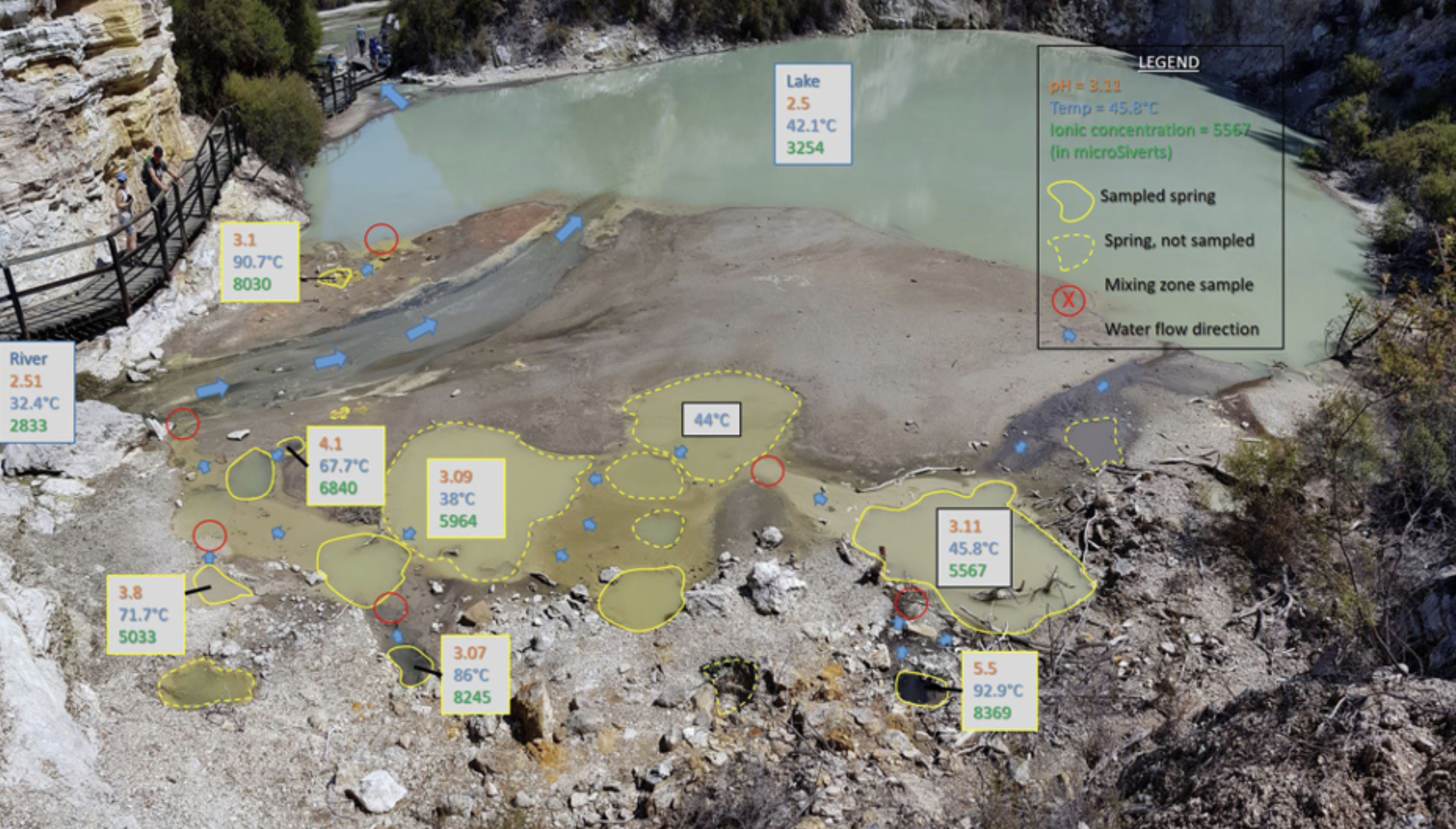
A collection of closely-spaced, diverse hot spring pools at Wai-O-Tapu, Rotorua, New Zealand, showing the chemical complexity present in a small area.
Investigations into early life in active and ancient hot springs (New Zealand/Dresser Formation) and the oldest life on Earth in Greenland and the Pilbara will continue.
Two PhD studies are expected to complete; one on thrombolites and the general environmental conditions of the reef complex; the other on unique branching kerogenous structures that appear to represent an early attempt of biological complexity, possibly even eukaryotic. The organic matter of this ancient life is also being investigated.
Published outputs for 2019
CCFS Publications: #1153, 1154, 1362, 1364, 1379, 1437, 1443, 1448, 1470.
10 Conference Abstracts
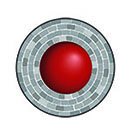
5. AUSTRALIA’S PROTEROZOIC RECORD IN A GLOBAL CONTEXT
Themes 2 and 3, Earth’s Evolution and Earth Today, contributing to understanding Earth’s Architecture.
AIMS
Earth’s history is considered to have been dominated by cycles of supercontinent formation and breakup. This program tests this hypothesis and its relevance to Australia’s geological evolution, assessing Australia’s positions during the supercontinent cycles by examining the paleomagnetic, petrological and detrital provenance record of the Australian and adjacent continents.
By studying primarily Australian rocks and comparing the results with global analogues, we aim to extend our knowledge about supercontinent cycles and the evolution of the Australian continent to the Paleoproterozoic or even further back in time. Such knowledge is fundamental for understanding the first-order fluid cycles that controlled the formation and redistribution of Earth resources, and the establishment of a 4D global geodynamic model covered in other Flagship Programs.
2019 REPORT
Since the completion of project funding in 2017, elements of this program have been incorporated within Z.X. Li’s Laureate Fellow project. Previously reported palaeomagnetic results from the 1.8 Ga Hart Dolerite and 1.89 Ga Boonadgin dykes were officially published in early 2019 (CCFS publications #1238 and #1123 respectively). Additional palaeomagnetic poles for the recently discovered 2.62 Ga and 1.39 Ga mafic dyke swarms from the Yilgarn Craton are still to be published and will be finalised in 2020. This work formed a significant part of the PhD thesis of Yebo Liu, which was submitted at the end of 2019.
Some additional palaeomagnetic work, performed in collaboration with a jointly appointed PhD student Wang Chong from the Institute of Geology and Geophysics, Chinese Academy of Sciences (and published in Science Bulletin), suggest the long-lived connection of the North Australian Craton to that of North China during the supercontinent Nuna. The work used palaeomagnetic as well as geological constraints to establish the evidence for this connection. One paper was published in Science Bulletin (CCFS publication #1432), and another paper has just been accepted for publication in Solid Earth (Wang et al., 2020).
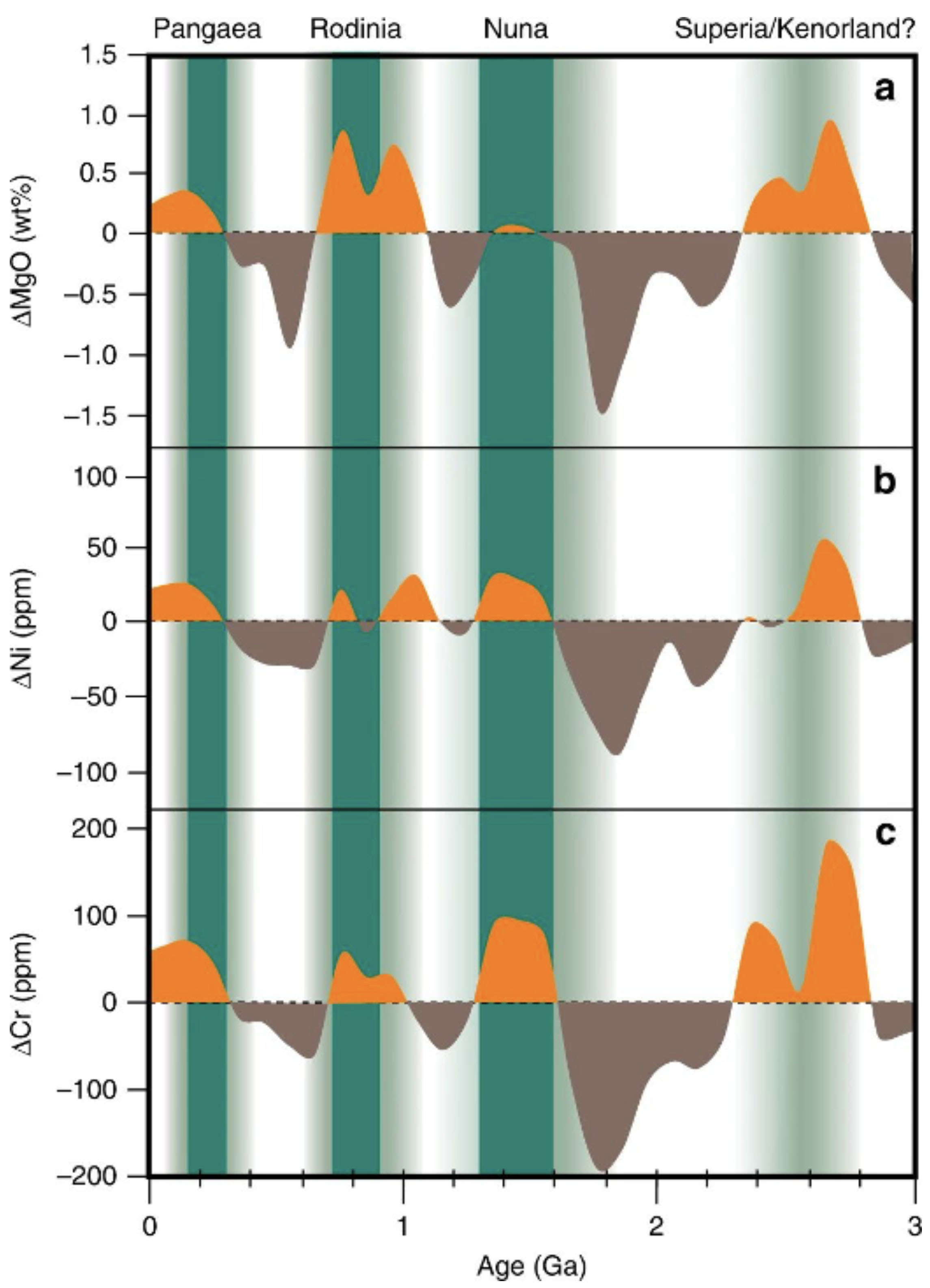
Figure 1. Global geochemical fingerprinting of plume intensity suggests coupling with the supercontinent cycle. The figure shows variability of global mean MgO, Ni and Cr in basalts after detrending the linear secular decreases. The major positive peaks at ~2.8–2.3 Ga, ~1.6–1.3 Ga, ~1.0–0.7 Ga, and ~0.3–0.0 Ga are broadly consistent with the tenures and break-up times of post-2 Ga supercontinents. The assembly and break-up of supercontinents are generally prolonged and multistage processes, which are marked by gradual green shading. See Gamal El Dien et al. Nature Communications, 10, 5270 for full caption (CCFS publication #1445).
Some other previously reported work (published early in 2019, CCFS publication #1242), which posited a global geodynamic model involving the superposition of a 1.2 Ga superocean cycle with a 600 Myr supercontinent cycle, received significant media attention through 2019 with numerous internet media articles (see links at the bottom of this link). This model also gained additional support from subsequent publications (the paper has already been cited 15 times within one year of publication).
As part of Li’s ARC Laureate Fellowship project, some additional significant publications have been generated by the oceanic-LIP sub-project. Together with Prof Li, Dr Doucet and PhD student Gamal El Dien (Fig. 1) we have published numerous high impact publications in 2019 relating to the geochemical signatures of mantle rocks and how they can be used to test the coupling between the supercontinent cycle and mantle dynamics ( Shall We Dance: Taking a 600 Million Year-long Step at a Time; Cr-Spinel Records Metasomatism Not Petrogenesis in Mantle Rocks; Origin of Arc Magmatic Signatures). This exciting work is continuing to develop, and many more publications are envisaged in 2020.
Work has also progressed on a global paleogeographic animation spanning the past two billion years. Initial animations, back to the Neoproterozoic, along with the integration of the geological record (Large Igneous Provices etc.) into the otherwise predominantly palaeomagnetic reconstructions were presented at numerous conferences throughout the year. This work will continue into 2020 with publications to follow.
A significant event of 2019 was the naming of Prof Zheng-Xiang Li as one of 62 new AGU Fellows. This honour was bestowed at the AGU Fall Meeting 2019 in San Francisco, California.
WORKPLAN 2020
Numerous new findings, supported by Li’s ARC Laureate Fellow project, are due to be published in 2020. Work will continue on the paleogeographic evolution of Australia in the Precambrian during 2020 utilising palaeomagnetism and geological evidence (including detrital zircon geochronology). The new palaeomagnetic poles from the 2.62 Ga and 1.39 Ga mafic dyke swarms of the Yilgarn Craton, a significant portion of Yebo Liu’s PhD work, will be published. Palaeomagnetic results obtained from northern WA and the North Australian Craton will also be published to elucidate the Paleoproterozoic assembly of proto-Australia. An additional publication describing a modified SWEAT configuration of Australia and Laurentia during Nuna is also forthcoming.
New global paleogeographic reconstructions that stretch into the Paleoproterozoic will be continually reported and published throughout 2020.
Published outputs for 2019
CCFS Publications: #1011, 1123, 1182, 1238, 1242, 1306, 1355, 1371, 1432, 1436, 1445, 1447, 1456, 1457, 1459, 1461, 1465, 1467, 1469, 1473, 1474.
>20 Conference Abstracts
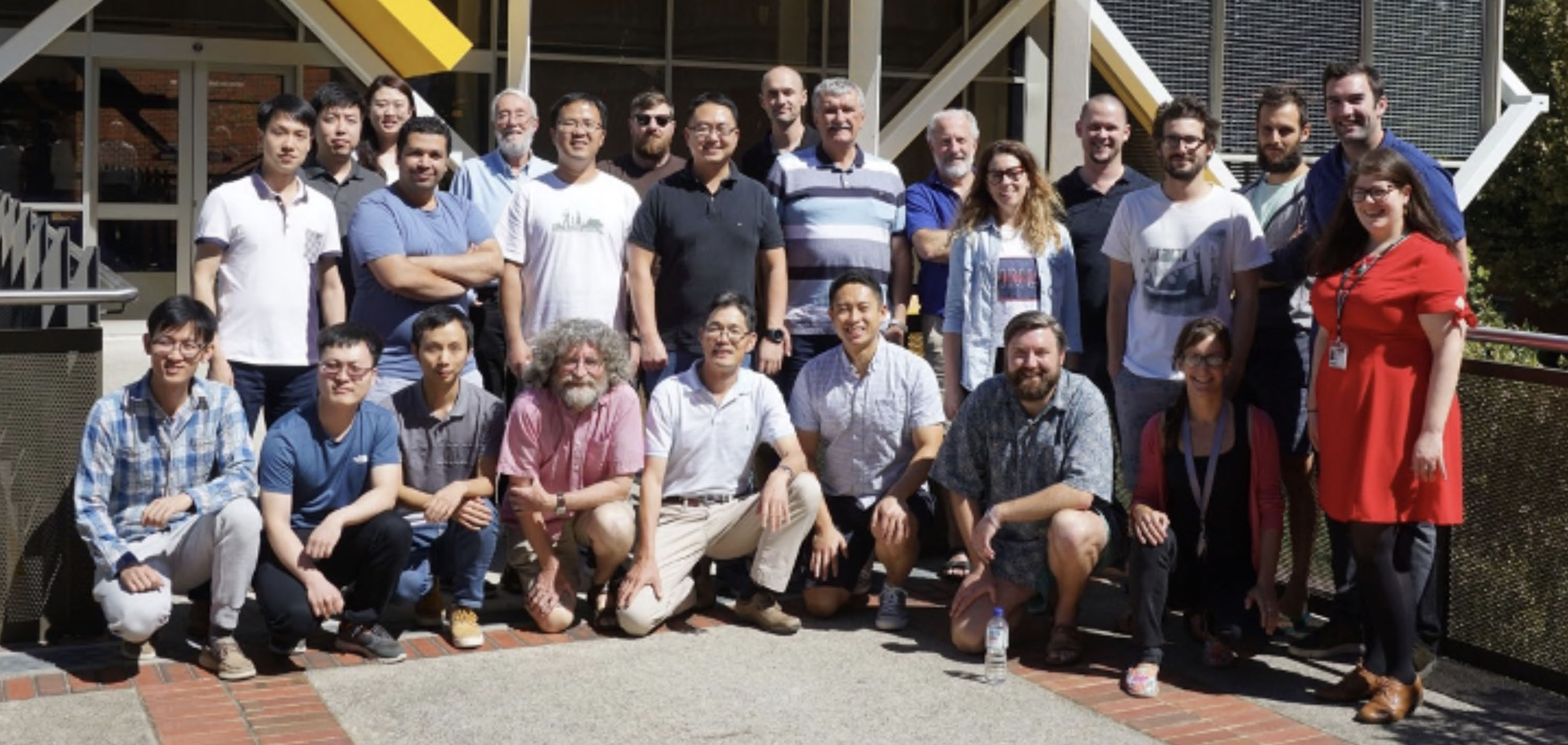
Earth Dynamics Research Group.

6. FLUID REGIMES AND THE COMPOSITION OF EARLY EARTH
Themes 1 and 3, Early Earth and Earth Today, contributing to understanding Earth’s Architecture and Fluid Fluxes.
AIMS
Zircon crystals are currently the only material that records events in the first 500 million years of Earth’s history, since no rocks have survived from this period and no other minerals have been established as Hadean in age. There is growing evidence from the study of these zircon crystals that the Earth stabilised rapidly after accretion and that both solid rock and liquid water were present within 150 million years of its formation. This program uses the geochemical signatures of zircon crystals from all known Hadean and early Archean localities, together with geochemistry of the oldest known rocks and the application of geophysical and geochemical modelling, to establish how the first crust formed, why it was destroyed and the role fluids played in this process. The changes that took place throughout the Archean are being evaluated as crustal processes evolved and plate tectonics became the dominant regime. A key component is determining the interaction between the mantle and the evolving crust. In addition, work undertaken on Martian meteorites and lunar samples is providing further constraints on the early history of the Solar System, especially the role played by fluids.
2019 REPORT
Work in 2019 was focused on the key regions on Earth containing examples of the earliest-formed crust (Antarctica, Labrador, Greenland and Tarim) and Hadean zircons (Jack Hills, Western Australia). In addition, work commenced on the 3.8 Ga rocks in the Ukrainian Shield with the appointment of Dr Leonid Shumlyanskyy as a post-doctoral fellow at Curtin, who took up the appointment in March 2019.
Further investigation of the Hadean and Eoarchean zircons from Jack Hills commenced with a number of local and international collaborators. Former CCFS post-doctoral fellow Dr Rongfeng Ge’s re-evaluation of the Jack Hills detrital zircon suite with respect to lead mobility was published in Earth and Planetary Science Letters (CCFS publication #1333, Fig. 1). In addition, we searched for lead nanospheres in a suite of zircons already investigated for the effects of recent weathering, involving former CCFS Marie Curie fellow Monika Kusiak and Dr Richard Wirth from Potsdam, Germany: the results will be published in 2020. A study of the trace elements in a suite of zircons ranging in age from 3.2 to 4.3 Ga was undertaken with Prof Simon Turner and the results were published in Nature Communications in 2020 (more on this next year!).

Figure 1. Pb images showing the internal structures, distribution of U-Pb isotopes, and calculated 207Pb/206Pb ages for various regions of interest (ROI) in Hadean zircon grain 23092. Colour scale indicates relative counts/pixel intensity of the ions. Note the first order control of the U, Th and Pb concentrations is by cracks, grain boundaries and CL zoning. Also note the presence of hotspots and patches of high 206Pb and 207Pb that do not correspond to high 238U. These hotspots and patches correspond to different growth zones. They have exceptionally high apparent 207Pb/206Pb ages, and incorporating them into ~20 μm elliptical ROIs (similar to SIMS spot) results in spuriously older 207Pb/206Pb ages. Scale bar is 20 μm. See CCFS publication #1333.
Further investigations of the distribution of the 3.7 Ga gneisses in the Tarim Craton continued in association with Associate Professor Rongfeng Ge from Nanjing University and a new paper was published in early 2020.
The Lu-Hf investigation of ancient zircon crystals from Aker Peaks in Kemp Land, Antarctica, proved to be more complex than originally envisaged and additional work was undertaken to resolve the issues. Metallic lead nanospheres identified in ancient zircons from the Napier Complex, Antarctica, were investigated by NanoSIMS and the work published in Scientific Reports.
Sample preparation and zircon separation continued on the samples collected in 2017 from the Saglek Bay area of Labrador, Canada, to further investigate the ancient gneiss complex. Two papers were published; one on a re-evaluation of the ancient Uivak gneisses (International Journal of Earth Sciences) and the other on the Neoarchean events affecting this ancient terrane (Geological Society of London).
Work commenced in West Greenland with a fieldtrip to Isua. Unfortunately, the weather was extremely inclement and we had only a limited time on the outcrops. However, a suite of samples was collected and shipped to Poland for initial preparation. The same bad weather that affected Greenland was also experienced on the opposite side of the Atlantic, and a planned trip to Labrador had to be cancelled.
Research continued in Antarctica with a grant from the Australian Antarctic Division to work on the legacy collection housed at Geoscience Australia in Canberra. The main aim is to investigate the extent of Eoarchean rocks across the Napier Complex. An additional aim is to resolve the extent of lead nanospheres in zircon across the complex and to establish how these might be related to the major metamorphic events. This project also involves Prof Martin Whitehouse in Stockholm and Prof Simon Harley in Edinburgh.
Lunar work in 2019 was focused on re-investigating the nature of the rocks at the Apollo landing sites and a series of papers were published. Work also continued on investigating lunar meteorites and also terrestrial impact craters, with special emphasis on the zircon signature. The identification that the lunar surface may possibly contain fragments of the Earth that were ejected when an asteroid struck was published in Earth and Planetary Science Letters in March 2019 (CCFS publication #1494) and is based on the ongoing study of material collected some 50 years ago from the Apollo 14 site. The sample contained quartz (extremely rare on the Moon) and zircon crystals unlike any previously described from the moon with respect to their geochemical signature.
WORKPLAN 2020
Work in Australia will remain focused on zircon from Jack Hills. Further work on Pb mobility in these grains will be undertaken using the atom probe to determine if lead nanospheres are present.
The atom probe investigation of lead (Pb) nanospheres in ancient zircons from the Napier Complex, Antarctica, will continue in order to precisely determine their distribution and isotopic composition. The full extent of Eoarchean rocks across the Napier Complex will be investigated using the legacy collection at Geoscience Australia.
Work will commence on samples collected from Isua, West Greenland in 2019, and continue on samples collected from Labrador in 2017. Work on the Eoarchean rocks of the Tarim Craton in China will likewise continue.
A new investigation of the Eoarchean and Hadean zircons in the Singhbhum Craton in India will commence in association with Dr Rajat Mazumder in Oman.
Work will continue on both lunar rocks and Martian meteorite samples with the aim of constraining the age of the oldest crust and the precise timing of events in the early solar system.
Published outputs for 2019
CCFS Publications: #1333, 1439, 1440, 1442, 1444, 1446, 1452, 1454, 1455, 1458, 1461, 1462, 1463, 1464, 1466, 1468, 1493, 1494, 1495, 1496, 1497, 1498.
9 Conference Abstracts

7. PRECAMBRIAN ARCHITECTURE AND CRUSTAL EVOLUTION IN WA
Themes 1, 2 and 3, Early Earth, Earth’s Evolution and Earth Today, contributing to understanding Earth’s Architecture.
AIMS
The enormous size and limited outcrop of the Neoarchean Yilgarn Craton and the Proterozoic orogens around its margins are detrimental to a deep understanding of what controls the distribution of mineral resources and which geodynamic processes were involved in the tectonic assembly of the Australian continent. The principal aim of this program is to combine geological, geochemical and geophysical techniques to propose a 3D structural model of the lithosphere of the Yilgarn Craton and its margins. This aim is predominantly addressed through passive source seismic experiments and integrated analysis of Hf-isotope data.
2019 REPORT
In 2019 the Geological Survey of Western Australia commissioned Velseis Integrated Technologies to conduct a 2D seismic survey along an aggregate 305 km in seven traverses in the Eastern Goldfields of Western Australia. Velseis also undertook an initial interpretation of the data, with input from GSWA geoscientists, to identify major features and structures visible in the data. The data and interpretation were released to the public in September and presented to industry at the annual ‘GSWA in the Goldfields’ event in Kalgoorlie in November (see photo below).
A major task of the seismic component was to wrap up a significant field campaign in late November 2019 in which 60 broadband temporary stations were deployed for over a year in the Canning regions (the Canning Seismic project).
Related to the Canning seismic project, a collaboration to deploy a semi-permanent real-time seismic station along the Canning coastal area was carried out with Geoscience Australia to improve the national network coverage in the region, which will improve the capability in hazard assessment and structural imaging. In November an outreach presentation about the general seismic tools and the purposes of the Canning project was presented to the council members of the Canning Shire.
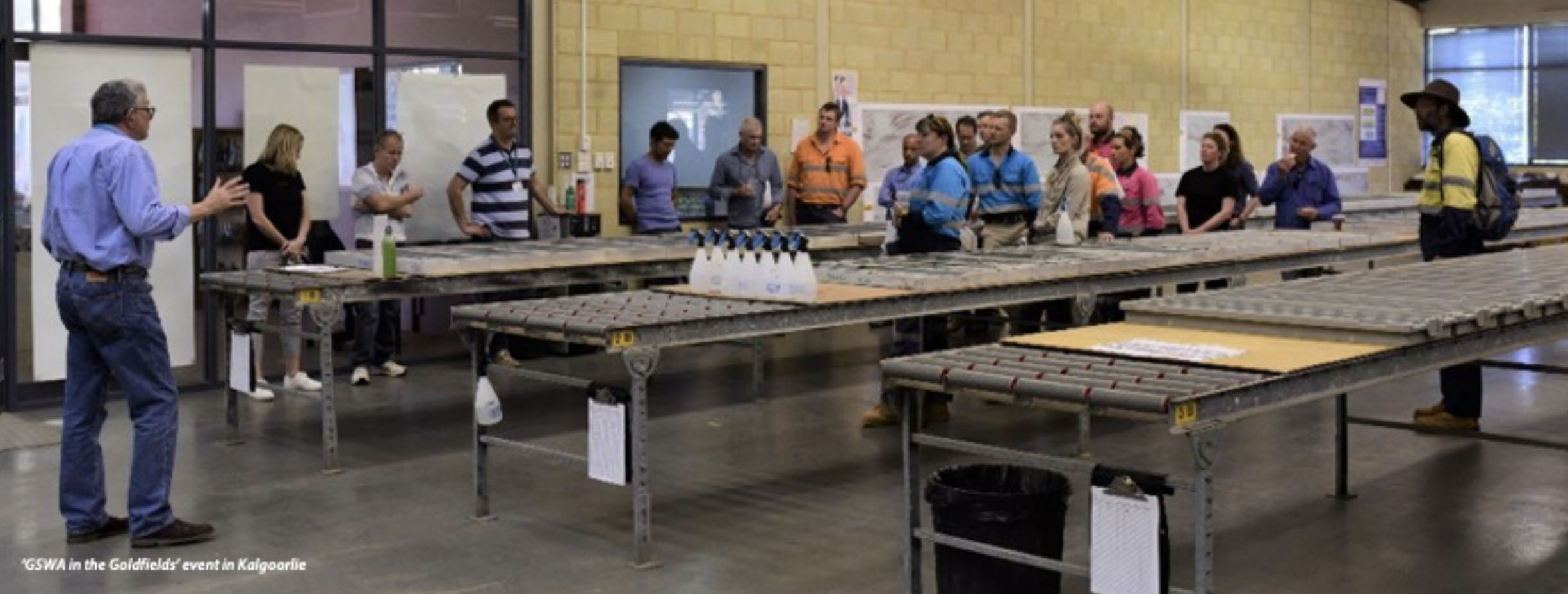
GSWA staff and exploration and mining industry practitioners at GSWA's Goldfields event, Joe Lord Core Library, Kalgoorlie, where new high-resolution seismic data was presented to industry along with relevant drillcore sections.
WORKPLAN 2020
The collected data from the Canning Seismic project will be analysed in 2020 to develop seismic velocity models of the crust and the shallow upper mantle which will provide tighter constraints to regional tectonic development and provide background (deep) knowledge for resources exploration purposes.
A related Chinese NSF proposal funded in 2019, starting in 2020, will expand the Canning project into the Archean cratonic regions. This 4-year project will also seek opportunities to put a second Ocean Bottom Seismic array offshore the Canning coastal region.
Published outputs for 2019
CCFS Publications: #1217, 1378, 1433, 1434, 1435.
8 Conference Abstracts
WHOLE OF CENTRE TECHNOLOGY DEVELOPMENT

1. CAMECA ION MICROPROBE DEVELOPMENT: MAXIMISING QUALITY AND EFFICIENCY OF CCFS ACTIVITIES WITHIN THE UWA ION PROBE FACILITY
Themes 1, 2 and 3, Early Earth, Earth’s Evolution and Earth Today, contributing to understanding Earth’s Architecture and Fluid Fluxes.
AIMS
The Ion Probe Facility within the CMCA at UWA is one of the best-equipped Secondary Ion Mass Spectrometry (SIMS) labs in the world. It houses a CAMECA IMS 1280 large-radius ion microprobe, for the high-precision analysis of stable isotopes in minerals, and two CAMECA NanoSIMS 50s for imaging mass spectrometry at the sub-micron scale. This program provides a dedicated Research Associate to facilitate CCFS activities and lead the development of standards and analytical protocols at the CMCA. This greatly benefits CCFS by increasing the capacity of the Facility, enabling a higher degree of interaction and participation on research projects, facilitating standards and protocols development, and allowing greater synergy with other CCFS node facilities.

2. FRONTIERS IN INTEGRATED LASER-SAMPLED TRACE ELEMENT AND ISOTOPIC GEOANALYSIS
Themes 1, 2 and 3, Early Earth, Earth’s Evolution and Earth Today, contributing to understanding Earth’s Architecture and Fluid Fluxes.
AIMS
The overall aim is to develop new analytical methods for in situ measurement of trace elements and isotope ratios to support and enable CCFS research programs and to provide new directions of research. Specific objectives include:
(1) combined trace element and isotope analysis - ‘split-stream’ analysis (presented Goldschmidt 2019, Gréau, Alard, O’Reilly)
(2) development of ‘non-traditional’ stable isotopes
(3) characterisation of reference materials for elemental and isotope ratio measurement (see CCFS publication #1330)
(4) development of data reduction software for combined trace element and isotope analysis

 ARC Centre of Excellence for Core to Crust Fluid Systems
ARC Centre of Excellence for Core to Crust Fluid Systems